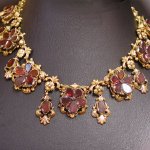We offer layaway, spread payments on the piece of your dreams. Ask us for details. Free insured shipping on all orders !!!

Antique jewelry glossary
Welcome to our extensive antique jewelry glossary with around 1,500 jewelry related entries.If you feel you are missing an explanation, feel free to let us know and we will add it.
A - B - C - D - E - F - G - H - I - J - K - L - M - N - O - P - Q - R - S - T - U - V - W - X - Y - Z all
Rococo Jewelry
(1720-1740)

See our: Rococo jewelry.
A style of decoration that followed, c.1730, the baroque style in France (where it was also called rocaille), the principal features of which are asymmetry of ornament and a repertoire consisting to a considerable extent of rockwork, shells, flowers, foliage, and scrollwork. It was developed in France under Louis XV, 1715-74, and spread to Italy, Germany, and Austria and to a lesser extent to England.
Rococo was followed, after the mid-l8th century, by the neo-classical style, generally termed in England 'Adam style'. As applied to jewelry, rococo was evidenced by the departure from the symmetrical arrangement of gem-stones (such as the frequent three pendent pearls)and the introduction, in patterns, of feathers, ribbons, and foliage. Leading exponents of the style among jewelry designers were Girolami Venturi (c. 1739), Thomas Flach (c. 1736), Albini (c. 1744),and Christian Taute (c. 1750).
In the second quarter of the 19th century, there was a period of 'revived rococo' style.
Want to know more about antique jewelry styles? Go to our antique jewelry style overview.
From: An Illustrated Dictionary of Jewelry, autor: Harold Newman, publishers: Thames and Hudson
Rococo
Rococo is a style of 18th century French art and interior design. Rococo style rooms were designed as total works of art with elegant and ornate furniture, small sculptures, ornamental mirrors, and tapestry complementing architecture, reliefs, and wall paintings. It was largely supplanted by the Neoclassic style.
The word Rococo is seen as a combination of the French rocaille, or shell, and the Italian barocco, or Baroque style. Due to Rococo love of shell-like curves and focus on decorative arts, some critics used the term to derogatively imply that the style was frivolous or merely fashion; interestingly, when the term was first used in English in about 1836, it was a colloquialism meaning "old-fashioned". However, since the mid 19th century, the term has been accepted by art historians. While there is still some debate about the historical significance of the style to art in general, Rococo is now widely recognized as a major period in the development of European art.
From: Wikipedia









